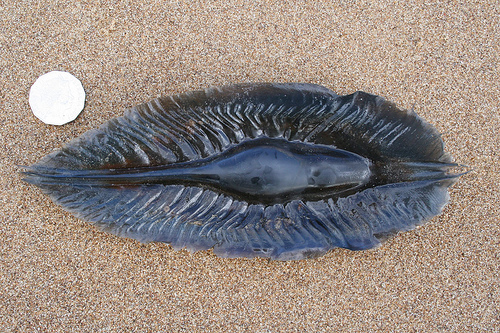by Peter Etnoyer
Sharks lay crazy eggs, but deep-sea catsharks and chimaeras lay some of the strangest eggs of all. If you’re a beachcomber, maybe you’ve seen these leathery "mermaid’s purses" washed up onshore. Did you come across any this summer? If you’re real lucky the rare and unique ones will wash up after a storm.
The egg cases of deep-sea sharks are adapted for survival in a cold, dark environment with little or no parental care. Their form follows their function- to remain in-place
and well-ventilated. This is no easy task in the deep water of the
continental shelf! Swift currents and predators abound.
Here are two examples, below. Ghost Shark egg cases from Tasmania resemble a kelp frond. Ghost sharks swim as deep 220 meters, and forage in the shallows at dusk. The Horn Shark swims to 150 meters. It lays eggs, too, but these are quite different. They take the form of a corkscrew, or auger, to help wedge it in place between the rocks until its ready to hatch (below).
Ghost shark egg case (top), credit nuytsia. Horn Shark egg case (bottom), credit elasmo-research.org.







The aquarium in Melbourne has an enormous, shallow tank containing a lot of ghost sharks. (The tank is supposed to represent a bay or something. I should pay more attention.) Anyway, I hadn’t seen them before so it was pretty cool. Those and the sea dragons, of course.
I would love to watch a sea dragon. Texas State Aquarium needs one of those. They do have a swell shark egg case display that’s backlit, so you can see the embryos growing inside.
Sorry about the image layout, by the way. The new interface is giving me problems. Hopefully the Disco overlords will find a way to fix it soon.
It would be really interesting to see how closely the Horned Shark’s egg case correlates to the Golden (Fibionacci) Spiral…
Being an occasional reader of this blog (in it’s various forms) I’d like to say that I’m mightily flattered that one of my pictures got on here.
Yay me! :-)